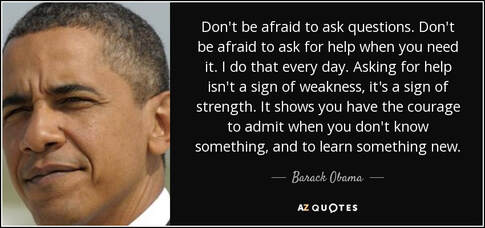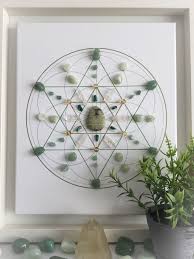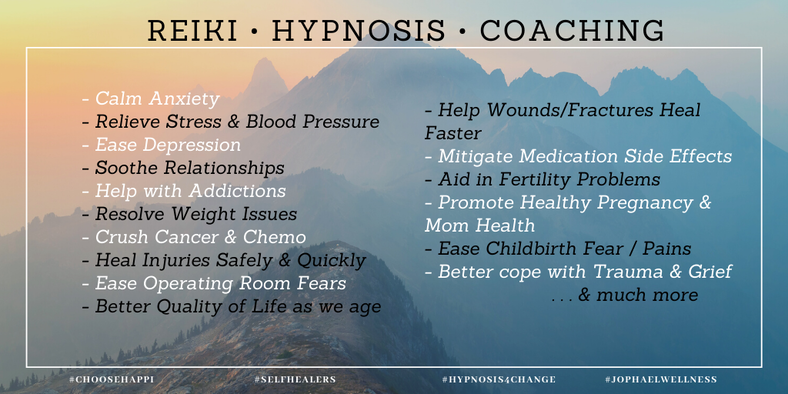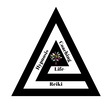Frequently Asked Questions
Click here to read about COVID Health & Safety measures at Jophael Wellness
Hypnosis FAQs
Can anyone go into hypnosis?
Yes anyone can. Hypnotic states are accessed all of the time by every human. We dream, day dream, get engrossed in a game or in an argument with another. These are all altered states. When someone is encouraged by another or takes themselves into a trance state you are just using a natural, unconscious ability deliberately.
Can you get stuck in hypnosis?
You can’t get stuck in hypnosis because REM (dream) state is just another brain state that people access both day and night. If someone is in the deepest trance possible or have a sleep debt, they might move into deep sleep and therefore be less easy to rouse; but are certainly not stuck.
How do I know if I have been in a hypnotic trance?
When a person experiences a relaxed hypnotic state, they might notice several things. Heaviness in the limbs, a sense of well being and a more relaxed mind. Sometimes if you are excessively drugged or drunk, rare psychoses, mental impairment can impede the process but most of these can be overcome by an experienced hypnotist. Sometimes it’s just a therapeutic mismatch, personality or trust issue.
Do you lose control or does the person doing hypnosis have total control over you?
You are more in control during a relaxed hypnotic state as your emotional brain is quiet and therefore you can think clearly. It has been shown many times that if the person doing the hypnosis asks you to do something that you don’t agree with then the tension causes the thinking brain to get involved and you come out of hypnosis.
Can you drive after being hypnotized?
If you have a sleep debt then you might drift off to sleep during or after the hypnosis session, so some people might feel a little sleepy but most people feel really rejuvenated by a period of hypnotic rest.
Why are habits so hard to break?
Habit are ingrained patterns we follow that at one time worked well. Over time they may become automatic and sometimes outdated or unhelpful. But since it is automatic change must be made at the subconscious level. The brain uses 25% of the calories we consume each day to work. In order to be efficient it automates a lot of processes. Habit breaking will require conscious effort which is not energy efficient and hence the brain does not choose it primarily.
Can hypnosis help anxiety and depression?
Hypnotic relaxation is extremely good for depression and anxiety. Hypnosis can be used to help free the sufferer from rigid patterns of thought, to remind them of better times and their positive resources.
How does hypnosis influence physical processes?
When we are sad, it may produce physical tears. Think about biting into a lemon? Our instincts can have profound physical responses or disruption on the body’s many systems, causing havoc with the digestive process, cardio vascular system and the immune and nervous systems. Hypnosis and the rejuvenating restful repair that it brings can help the healing process.
What is the difference between PTSD and CPTSD?
When we experience a single traumatic episode that you flashback into when your brain recognizes something similar is called PTSD. When the traumatic or frightening episodes are drawn out over a period of time it is called CPTSD.
Can anyone go into hypnosis?
Yes anyone can. Hypnotic states are accessed all of the time by every human. We dream, day dream, get engrossed in a game or in an argument with another. These are all altered states. When someone is encouraged by another or takes themselves into a trance state you are just using a natural, unconscious ability deliberately.
Can you get stuck in hypnosis?
You can’t get stuck in hypnosis because REM (dream) state is just another brain state that people access both day and night. If someone is in the deepest trance possible or have a sleep debt, they might move into deep sleep and therefore be less easy to rouse; but are certainly not stuck.
How do I know if I have been in a hypnotic trance?
When a person experiences a relaxed hypnotic state, they might notice several things. Heaviness in the limbs, a sense of well being and a more relaxed mind. Sometimes if you are excessively drugged or drunk, rare psychoses, mental impairment can impede the process but most of these can be overcome by an experienced hypnotist. Sometimes it’s just a therapeutic mismatch, personality or trust issue.
Do you lose control or does the person doing hypnosis have total control over you?
You are more in control during a relaxed hypnotic state as your emotional brain is quiet and therefore you can think clearly. It has been shown many times that if the person doing the hypnosis asks you to do something that you don’t agree with then the tension causes the thinking brain to get involved and you come out of hypnosis.
Can you drive after being hypnotized?
If you have a sleep debt then you might drift off to sleep during or after the hypnosis session, so some people might feel a little sleepy but most people feel really rejuvenated by a period of hypnotic rest.
Why are habits so hard to break?
Habit are ingrained patterns we follow that at one time worked well. Over time they may become automatic and sometimes outdated or unhelpful. But since it is automatic change must be made at the subconscious level. The brain uses 25% of the calories we consume each day to work. In order to be efficient it automates a lot of processes. Habit breaking will require conscious effort which is not energy efficient and hence the brain does not choose it primarily.
Can hypnosis help anxiety and depression?
Hypnotic relaxation is extremely good for depression and anxiety. Hypnosis can be used to help free the sufferer from rigid patterns of thought, to remind them of better times and their positive resources.
How does hypnosis influence physical processes?
When we are sad, it may produce physical tears. Think about biting into a lemon? Our instincts can have profound physical responses or disruption on the body’s many systems, causing havoc with the digestive process, cardio vascular system and the immune and nervous systems. Hypnosis and the rejuvenating restful repair that it brings can help the healing process.
What is the difference between PTSD and CPTSD?
When we experience a single traumatic episode that you flashback into when your brain recognizes something similar is called PTSD. When the traumatic or frightening episodes are drawn out over a period of time it is called CPTSD.
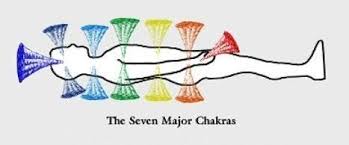 Jophael Wellness: Image Showing The Seven Major Chakras
Jophael Wellness: Image Showing The Seven Major Chakras
Reiki FAQs
What is Reiki?
Reiki (ray-key) in Japanese literally means Universal Life force energy.
Life force flows within our physical body though pathways called chakras, meridians and nadis. It also flows around us in a field of energy called the aura. Reiki heals by flowing through the disrupted/blocked parts of the energy field and charges them with positive energy breaking apart negativity, nourishing the mind, organs and cells of the body, supporting them in their vital functions and balancing the energy within and out. Healing occurs as a natural consequence in an Alpha (relaxed) state.
Is Reiki FDA approved?
The FDA primarily regulates medical devices and pharmaceuticals, and Reiki is considered a complementary or alternative therapy rather than a medical treatment. Reiki as a practice does not undergo FDA approval in the same way that medications or medical devices do. It is always recommended to consult with a qualified healthcare provider for advice on medical treatments and to use therapies like Reiki as adjuncts to, rather than replacements for, conventional medical care. The National Center for Complementary and Integrative Health (NCCIH) states 'Reiki hasn’t been shown to have any harmful effects.'
How does Reiki work?
At a Reiki session, an attuned Reiki practitioner (a channel for this energy) transmits this energy via a gentle, therapeutic nurturing (direct or indirect) touch. Energy flows to wherever healing is needed first. Using crystals amplifies Reiki’s efficacy. Healing via Reiki is safe for use on adults, children, animals, plants and for spaces that we live and work in.
Will Reiki heal me?
Chronic conditions may require a series of sessions for homeostasis to occur. It is helpful to try and relax and not let expectations get in the way of healing. Reiki is one part of an integrative healing or wellness team that keep you healthy. It does not offer a guaranteed cure nor should be a substitute for medical/professional mind/body care. Reiki practitioners do not diagnose conditions nor do they prescribe medicine or perform medical treatment.
Is there a science behind Reiki?
In the 1970s, bio-magnetic research showed that certain magnetic fields could stimulate the growth process in bone fractures that resisted healing. Soon after, the FDA approved Pulsing Electro-Magnetic Field Therapy (PEMF) for bone healing, in which wire coils placed near a fracture induce electrical current flows in the bone. The necessary frequency range is 7 Hz. Dr. John Zimmerman measured the magnetic field frequencies of Reiki and other energy practitioners, while they worked on clients. He found that the practitioners all emitted ELF (extremely low frequency) frequencies from their hands. The frequency measured most often from the hands of energy therapists is 7 Hz; the same frequency as the PEMF device approved by the FDA for stimulating bone growth. Full article.
What are Chakras?
The chakras are subtle energy control centers running along the spinal cord and channels (meridians) dispersed all over the body. Each chakra corresponds to different organ system / meridian and vibrates at a different frequency. Chakras vibrate from inside the physical body to the outside, pulling external universal vibrations into our bodies. Our aura radiates information to the universe and back in a closely attuned quantum equilibrium dance.
Explain Reiki & Chakras?
Anytime the hands of a Reiki practitioner "touch with healing intention" be it self, another person, animal, plant, property or space - healing energy flows freely and strongly mainly through the chakras (subtle energy control centers) running along the spinal cord and channels (meridians) dispersed all over the body. Each chakra corresponds to different organ system / meridian and vibrates at a different frequency. The aim is to bring equilibrium to misaligned chakras within & without, through a variety of skilled techniques & maneuvers.
Does energy from the practitioner and client mix with each other?
The practice of Reiki differs from other energy modalities, in that Reiki practitioners are "attuned" to channel universal life-force energy. This acts as a barrier to enmeshment of personal 'qi' with the person who is being healed. Attunement is a process much like positioning and fine tuning an antenna for optimal reception. The more Reiki is channeled the stronger the signal gets.
Is Reiki the same as other energy modalities?
Reiki is one form of an energy modality. Others are acupuncture, chi-gong, theta healing, etc. It differs in that the practitioner's and client's personal energy do NOT enmesh.
Can I self-heal?
The beauty of Reiki is that an attuned practitioner can utilize Reiki to for their own wellness and enhanced well-being. In fact, regular self-healing practice must become a prerequisite before offering Reiki to others.
Does Distant Healing really work?
"The Science Behind Distant Healing" is an illuminating article that was published in the Reiki Times (2009).
Will Reiki interfere with my traditional treatment or therapy?
Institutional settings from hospitals to hospices are recognizing and offering Reiki alongside traditional medicine/therapy to maximize patient care and minimize recovery time. It can also aid the healing or recovery process while patients are undergoing chemotherapy or are recovering from illness, injuries or surgeries or to even strengthen the body before and after these invasive procedures. The body cannot fight illness and heal at the same time. It must do one or the other.
How does using Crystals with Reiki help?
Each step in the formation of a crystal, stores ENERGY. Different areas of the planet hold different and unique energies, which affect the crystal's growth and healing effectiveness too. The premise of working with chakra stones or crystals is that each stone has the purpose of magnifying or balancing the energy center (chakra) you are focusing on. In order to choose a healing crystal, you have to look at several stone attributes, including its energetic quality, color, and the intuitive or personal resonance you have with it.
What is a Crystal Grid (see image above) ?
Crystal grids are special arrangements of healing stones, used with intention, to manifest a desired result. In a Reiki session or in your home/office/car, you can use crystals at strategic points of energy flow/exchange on the body (chakras, meridians, nadis) or at merging points of sacred geometry for different purposes eg: an abundance grid, wealth attraction grid, love grid, world peace grid and so on. Using crystal grids knowledgeably can be very powerful, as it combines the energy of the stone with Sacred Geometry (the language of the Universe).
How should I prepare for my session?
Having positive belief that your body is capable of healing itself to a degree greater than anyone has ever permitted you to believe, will go a long way toward achieving the goal that brought you here. Learning to reframe your thoughts is a valuable skill that will help you heal faster as it is our untrained thoughts & emotions that aid an atmosphere of dis’ease’ in the mind and body. (Reframing is offered as a separate modality under Life Coaching & Hypnosis and is not included in a regular Reiki session. Please ask for details).
Privacy?
Your privacy is respected. No information is ever shared unless enforced by law.
I would like to learn Reiki? Where do I begin?
In today's Reiki PROFESSIONAL world, your Reiki Master's lineage matters. While you can learn Reiki 1,2, advanced, etc for a fair price, if you want to teach, a Mastership is expected that can run anywhere $5000 and up and at least 6months apprenticeship from an establishment of good repute.
For working/volunteering a minimum Reiki 2 is expected. At most places you work, you will either have to give a percentage of what you make, work for a spa type place at salary, or both. If you start out on your own, you of course get to keep anything you charge but there are costs of rent, doing business and getting clients in through the door.
For general purposes to practice Reiki healing on yourself/family/friends, Reiki can be learnt from any practitioner who can confer attunement. Initially your Reiki practice will consist of placing your attuned hand chakras and intention in a pattern taught by your Reiki teacher. With practice you will perceive what the Reiki energy reveals to you (the advanced art of Byosen Scanning) i.e listening to the body of the client and the workings of the energy rather than relying on a specific pattern of hand positions to increase the effectiveness of Reiki and encouraging an outcome.
What is Reiki?
Reiki (ray-key) in Japanese literally means Universal Life force energy.
Life force flows within our physical body though pathways called chakras, meridians and nadis. It also flows around us in a field of energy called the aura. Reiki heals by flowing through the disrupted/blocked parts of the energy field and charges them with positive energy breaking apart negativity, nourishing the mind, organs and cells of the body, supporting them in their vital functions and balancing the energy within and out. Healing occurs as a natural consequence in an Alpha (relaxed) state.
Is Reiki FDA approved?
The FDA primarily regulates medical devices and pharmaceuticals, and Reiki is considered a complementary or alternative therapy rather than a medical treatment. Reiki as a practice does not undergo FDA approval in the same way that medications or medical devices do. It is always recommended to consult with a qualified healthcare provider for advice on medical treatments and to use therapies like Reiki as adjuncts to, rather than replacements for, conventional medical care. The National Center for Complementary and Integrative Health (NCCIH) states 'Reiki hasn’t been shown to have any harmful effects.'
How does Reiki work?
At a Reiki session, an attuned Reiki practitioner (a channel for this energy) transmits this energy via a gentle, therapeutic nurturing (direct or indirect) touch. Energy flows to wherever healing is needed first. Using crystals amplifies Reiki’s efficacy. Healing via Reiki is safe for use on adults, children, animals, plants and for spaces that we live and work in.
Will Reiki heal me?
Chronic conditions may require a series of sessions for homeostasis to occur. It is helpful to try and relax and not let expectations get in the way of healing. Reiki is one part of an integrative healing or wellness team that keep you healthy. It does not offer a guaranteed cure nor should be a substitute for medical/professional mind/body care. Reiki practitioners do not diagnose conditions nor do they prescribe medicine or perform medical treatment.
Is there a science behind Reiki?
In the 1970s, bio-magnetic research showed that certain magnetic fields could stimulate the growth process in bone fractures that resisted healing. Soon after, the FDA approved Pulsing Electro-Magnetic Field Therapy (PEMF) for bone healing, in which wire coils placed near a fracture induce electrical current flows in the bone. The necessary frequency range is 7 Hz. Dr. John Zimmerman measured the magnetic field frequencies of Reiki and other energy practitioners, while they worked on clients. He found that the practitioners all emitted ELF (extremely low frequency) frequencies from their hands. The frequency measured most often from the hands of energy therapists is 7 Hz; the same frequency as the PEMF device approved by the FDA for stimulating bone growth. Full article.
What are Chakras?
The chakras are subtle energy control centers running along the spinal cord and channels (meridians) dispersed all over the body. Each chakra corresponds to different organ system / meridian and vibrates at a different frequency. Chakras vibrate from inside the physical body to the outside, pulling external universal vibrations into our bodies. Our aura radiates information to the universe and back in a closely attuned quantum equilibrium dance.
Explain Reiki & Chakras?
Anytime the hands of a Reiki practitioner "touch with healing intention" be it self, another person, animal, plant, property or space - healing energy flows freely and strongly mainly through the chakras (subtle energy control centers) running along the spinal cord and channels (meridians) dispersed all over the body. Each chakra corresponds to different organ system / meridian and vibrates at a different frequency. The aim is to bring equilibrium to misaligned chakras within & without, through a variety of skilled techniques & maneuvers.
Does energy from the practitioner and client mix with each other?
The practice of Reiki differs from other energy modalities, in that Reiki practitioners are "attuned" to channel universal life-force energy. This acts as a barrier to enmeshment of personal 'qi' with the person who is being healed. Attunement is a process much like positioning and fine tuning an antenna for optimal reception. The more Reiki is channeled the stronger the signal gets.
Is Reiki the same as other energy modalities?
Reiki is one form of an energy modality. Others are acupuncture, chi-gong, theta healing, etc. It differs in that the practitioner's and client's personal energy do NOT enmesh.
Can I self-heal?
The beauty of Reiki is that an attuned practitioner can utilize Reiki to for their own wellness and enhanced well-being. In fact, regular self-healing practice must become a prerequisite before offering Reiki to others.
Does Distant Healing really work?
"The Science Behind Distant Healing" is an illuminating article that was published in the Reiki Times (2009).
Will Reiki interfere with my traditional treatment or therapy?
Institutional settings from hospitals to hospices are recognizing and offering Reiki alongside traditional medicine/therapy to maximize patient care and minimize recovery time. It can also aid the healing or recovery process while patients are undergoing chemotherapy or are recovering from illness, injuries or surgeries or to even strengthen the body before and after these invasive procedures. The body cannot fight illness and heal at the same time. It must do one or the other.
How does using Crystals with Reiki help?
Each step in the formation of a crystal, stores ENERGY. Different areas of the planet hold different and unique energies, which affect the crystal's growth and healing effectiveness too. The premise of working with chakra stones or crystals is that each stone has the purpose of magnifying or balancing the energy center (chakra) you are focusing on. In order to choose a healing crystal, you have to look at several stone attributes, including its energetic quality, color, and the intuitive or personal resonance you have with it.
What is a Crystal Grid (see image above) ?
Crystal grids are special arrangements of healing stones, used with intention, to manifest a desired result. In a Reiki session or in your home/office/car, you can use crystals at strategic points of energy flow/exchange on the body (chakras, meridians, nadis) or at merging points of sacred geometry for different purposes eg: an abundance grid, wealth attraction grid, love grid, world peace grid and so on. Using crystal grids knowledgeably can be very powerful, as it combines the energy of the stone with Sacred Geometry (the language of the Universe).
How should I prepare for my session?
Having positive belief that your body is capable of healing itself to a degree greater than anyone has ever permitted you to believe, will go a long way toward achieving the goal that brought you here. Learning to reframe your thoughts is a valuable skill that will help you heal faster as it is our untrained thoughts & emotions that aid an atmosphere of dis’ease’ in the mind and body. (Reframing is offered as a separate modality under Life Coaching & Hypnosis and is not included in a regular Reiki session. Please ask for details).
Privacy?
Your privacy is respected. No information is ever shared unless enforced by law.
I would like to learn Reiki? Where do I begin?
In today's Reiki PROFESSIONAL world, your Reiki Master's lineage matters. While you can learn Reiki 1,2, advanced, etc for a fair price, if you want to teach, a Mastership is expected that can run anywhere $5000 and up and at least 6months apprenticeship from an establishment of good repute.
For working/volunteering a minimum Reiki 2 is expected. At most places you work, you will either have to give a percentage of what you make, work for a spa type place at salary, or both. If you start out on your own, you of course get to keep anything you charge but there are costs of rent, doing business and getting clients in through the door.
For general purposes to practice Reiki healing on yourself/family/friends, Reiki can be learnt from any practitioner who can confer attunement. Initially your Reiki practice will consist of placing your attuned hand chakras and intention in a pattern taught by your Reiki teacher. With practice you will perceive what the Reiki energy reveals to you (the advanced art of Byosen Scanning) i.e listening to the body of the client and the workings of the energy rather than relying on a specific pattern of hand positions to increase the effectiveness of Reiki and encouraging an outcome.
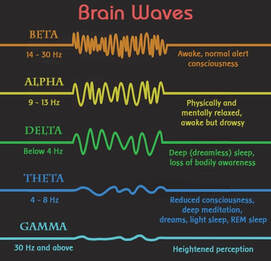 Modalities like Reiki affect healing at the Alpha frequency, hypnosis at REM (Theta or Delta) depending how deeply in trance you allow yourself to go.
Modalities like Reiki affect healing at the Alpha frequency, hypnosis at REM (Theta or Delta) depending how deeply in trance you allow yourself to go.
HypnoReiki FAQs
What is HypnoReiki?
I combine Hypnosis & Reiki into one powerful session to guide you to a deeper learning state at which change/healing is attained subconsciously.
(Reiki is a Japanese technique for relaxation healing on a physical, mental, emotional and spiritual level. Neither a religious belief nor faith in Reiki's therapeutic ability, is required. It is safe with no contraindications. Other than the laying of hands directly or, if preferred, indirectly, no oils or products are used. By using indirect touch, it can be used where extra care and caution is required eg. injury sites, before and post operation, during chemotherapy, elderly, dying or on newborns/children.
Hypnosis is a naturally or guided state of relaxed, focused attention. Hypnosis cannot make you do something against your will or give out sensitive information. You need not prior experience.)
In HypnoReiki, why do you mix somatic (of the body) modalities like Reiki with cognitive (of the mind) modalities like Hypnosis?
In the image, our active focused brain works on the Beta frequency level. Researchers find that healing takes place at alpha and below. Reiki, massage, acupuncture usually gently relaxes a person to the alpha level. With Hypnosis one can easily access delta and more deeper levels lowering the stress response (Ohio State University study*) and boosting immunity (Washington State University study, Pullman**). It’s now well established that your thoughts and feelings have a profound impact on your physical health. Using both is taking advantage of the strong mind-body connection to bring about change and homeostasis quickly and naturally.
*Ruzyla-Smith P, Barabasz A, Barabasz M, Warner D. Effects of hypnosis on the immune response: B-cells, T-cells, helper and suppressor cells. American Journal of Clinical Hypnosis. 1995 Oct; 38(2):71-9.
**Kiecolt-Glaser JK, Page GG, Marucha PT, MacCallum RC, Glaser R (1998). Psychological influences on surgical recovery: Perspectives from psychoneuroimmunology. American Psychologist 53:1209-1218.
What is HypnoReiki?
I combine Hypnosis & Reiki into one powerful session to guide you to a deeper learning state at which change/healing is attained subconsciously.
(Reiki is a Japanese technique for relaxation healing on a physical, mental, emotional and spiritual level. Neither a religious belief nor faith in Reiki's therapeutic ability, is required. It is safe with no contraindications. Other than the laying of hands directly or, if preferred, indirectly, no oils or products are used. By using indirect touch, it can be used where extra care and caution is required eg. injury sites, before and post operation, during chemotherapy, elderly, dying or on newborns/children.
Hypnosis is a naturally or guided state of relaxed, focused attention. Hypnosis cannot make you do something against your will or give out sensitive information. You need not prior experience.)
In HypnoReiki, why do you mix somatic (of the body) modalities like Reiki with cognitive (of the mind) modalities like Hypnosis?
In the image, our active focused brain works on the Beta frequency level. Researchers find that healing takes place at alpha and below. Reiki, massage, acupuncture usually gently relaxes a person to the alpha level. With Hypnosis one can easily access delta and more deeper levels lowering the stress response (Ohio State University study*) and boosting immunity (Washington State University study, Pullman**). It’s now well established that your thoughts and feelings have a profound impact on your physical health. Using both is taking advantage of the strong mind-body connection to bring about change and homeostasis quickly and naturally.
*Ruzyla-Smith P, Barabasz A, Barabasz M, Warner D. Effects of hypnosis on the immune response: B-cells, T-cells, helper and suppressor cells. American Journal of Clinical Hypnosis. 1995 Oct; 38(2):71-9.
**Kiecolt-Glaser JK, Page GG, Marucha PT, MacCallum RC, Glaser R (1998). Psychological influences on surgical recovery: Perspectives from psychoneuroimmunology. American Psychologist 53:1209-1218.
